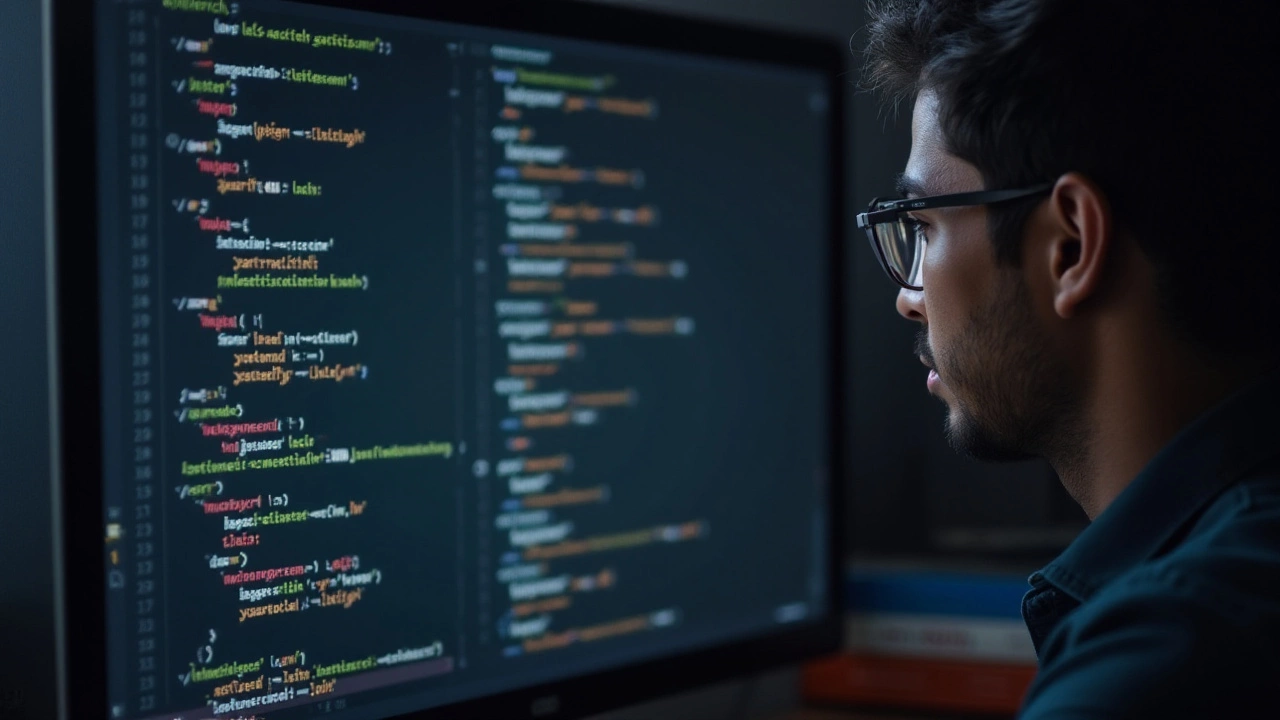In the world of programming, there's an axiom that stands taller than the rest: the golden rule of coding. While not enshrined in stone, it holds a revered place in the hearts of developers everywhere. This rule isn't about following a specific syntax or wielding the quirkiest tools; rather, it's about crafting code that anyone can easily understand. What use is a masterpiece of efficiency if no one else can decipher its beauty?
Programming is as much for people as it is for machines. A crucial part of this process is creating code that speaks clearly. Simplicity and readability form the backbone of effective coding practices, paving the way for better collaboration and smoother project transitions. Let us embark on a journey to understand why readable code is so critical and how you can start implementing these practices to elevate your programming game.
- Understanding the Golden Rule
- Benefits of Readable Code
- Essential Practices for Clean Coding
- Common Mistakes to Avoid
Understanding the Golden Rule
The golden rule of coding is simple: write code for humans first, computers second. This basic tenet underscores the necessity of clean code practices, enabling anyone who stumbles upon your work to comprehend and modify it as needed. Writing clean code is about maintaining clarity, providing a narrative that doesn’t lose its thread amidst complexities. It's about crafting a story—one that gracefully guides others through logic and process, making the journey both educational and enjoyable. Where confusion could reign, simplicity seeks to bring order, much like a maestro conducting a symphony.
In practice, following this rule involves several strategies, such as incorporating descriptive naming conventions and ensuring consistent style throughout. When a function does what its name suggests, time spent deciphering its purpose diminishes significantly. This ultimately leads to fewer errors and improved collaboration, as developers can easily pick up and continue someone else's work. As software landscape continuously evolves, adopting this golden rule helps fortify a foundation of trust and efficiency within a team.
“Programs must be written for people to read, and only incidentally for machines to execute.” — Harold Abelson, co-author of 'Structure and Interpretation of Computer Programs'
An often overlooked benefit of writing readable code is how it opens pathways for innovation. When every team member easily grasps the codebase, they contribute insights and ideas without the fear of breaking something they don’t understand. Innovators like Steve Wozniak have emphasized how important legible code was to the advancements of Apple during its formative years. Much of their success can be attributed to a well-documented, easy-to-follow code that allowed quick pivots and rapid development. In this sense, the golden rule fosters an environment where evolution is possible rather than oppressive.
Yet, while the importance of code readability has been established, statistics can illustrate why adherence to this principle remains crucial even today. Consider that the Software Engineering Institute reveals maintainability accounts for up to 80% of total project costs in the software lifecycle. Imagine the savings and efficiencies, not just in terms of cost but time, one could achieve by committing to this practice from the beginning. Developers, project managers, and business leaders alike have a vested interest in appreciating code readability, where effective practices can seal financial and operational benefits too alluring to ignore.

Benefits of Readable Code
When diving into the labyrinth of software development, it's easy to overlook the fundamental importance of readable code. At its core, readable code is about communication, ensuring that your logic is as accessible to future-you as it is to teammates, collaborators, or the open source community. It makes the difference between code that gets tossed into the abyss and code that contributes to a collective leap forward in innovation. In the churn of development cycles, one often returns to old code—sometimes months or years later. Those who grasp the significance of clean and understandable code reap the rewards of smoother project updates and streamlined development processes.
A study conducted by the University of California, cited by many tech enthusiasts, revealed that developers spend nearly 50% of their time reading code as opposed to writing it. With this insight, the significance of code readability becomes unmistakable. Introduce bad habits, and you'll find that errors multiply, code reviews become battlegrounds, and onboarding processes stretch to longer timelines. Readable code helps mitigate these issues by encouraging clarity and simplicity across team dynamics. As coding communities continue to grow and diversify, maintaining a unified approach has become ever more vital.
Let's not forget about the tangible benefits clean code brings to collaboration. When code is intelligible, it saves time by preventing lengthy explanations. Each line of code written that adheres to readability standards reduces friction in collaborative settings. There is a remarkable quote from the legendary programmer John Carmack that often comes to mind:
“Clean code can be read, and enhanced by a developer other than its original author.”He highlights a truth many veterans have learned: documentation, while necessary, is dwarfed by the added value of cohesively written code. From experience, we know that the less effort one needs to understand existing code, the more rapidly one can drive a project forward.
Start-ups and tech giants both stand to gain from the advantages readable code brings to the maintenance and scalability of their applications. Clean code allows for straightforward debugging, meaning errors can be traced and resolved faster. This efficiency is coupled with increased adaptability; new features and improvements are seamlessly integrated when the underlying structures are well-constructed. Delving into complex codebases becomes far less daunting when they are organized transparently, and talent retention improves as developers enjoy a cleaner work environment. In the realm of shared coding projects, readable code acts as a bridge connecting proficiency with creativity, ushering in a new wave of innovation.

Essential Practices for Clean Coding
Clean coding revolves around crafting code that's not only correct and efficient but also accessible and easy to understand for anyone working with it in the future. It's an art of weaving simplicity into the complexity of software development, ensuring that code is a legible narrative rather than an indecipherable script. The topmost rule in achieving clean code is prioritizing clarity. This means diving head-first into descriptive variable names; instead of simple letters like 'x' or 'y', consider conveying their purpose directly, like 'userAge' or 'transactionDate'. One might feel that meaningful names take up more space but remember, the lost brevity is gained tenfold in comprehension.
Another pillar of clean coding is consistent code formatting. Just as a beautifully organized novel is easier to read than a jumbled collection of words, well-formatted code guides the reader's eyes gracefully through its logic. It's beneficial to consider adopting a standardized format or style guide pertinent to the particular programming language you’re using. This uniform structure demystifies diverse segments of the code, nurturing harmony across various developers' inputs. Styles can include consistent use of indentation, strategic placement of brackets, and reliable spacing. An often overlooked yet powerful practice is including comments within the code. These annotations act as signposts, illuminating the coder's thought process, clarifying complex segments, and providing context for those who will later maintain the program.
Embracing these practices allows coding teams to operate more like well-oiled machines. An engaging quote from the renowned programmer Robert C. Martin sums this up,
"The ratio of time spent reading versus writing is well over 10 to 1. We are constantly reading old code as part of the effort to write new code. Because this ratio is so high, we want the reading of code to be easy, even if it makes the writing harder."Understanding the significance of this balance can prevent countless hours lost to deciphering bewildering scripts. It's vital to break down complex functions or methods into smaller, digestible blocks or modules. Each module should have a single responsibility, making it easier to test and maintain, as well as fostering reuse in future projects.
| Clean Coding Practice | Benefit |
|---|---|
| Descriptive Variable Names | Enhanced Readability |
| Consistent Formatting | Improved Code Structure |
| Effective Commenting | Better Understanding of Code Logic |
| Modular Code Design | Increased Flexibility and Reusability |
Following these essential practices for clean coding can elevate a team's ability to refine and progress projects with greater efficiency and fewer hurdles. Ensuring code is readable isn't merely a choice—it's a commitment to quality that cultivates a more inclusive and collaborative environment. By embedding these practices deeply into your coding culture, you stand to significantly enhance not just the quality of your code but your entire programming experience, ultimately contributing to smoother workflows and superior software solutions.

Common Mistakes to Avoid
When it comes to coding, even the most skilled programmers can fall into traps that compromise the clarity and effectiveness of their work. One major blunder is neglecting code readability. Some developers get caught in the allure of clever tricks and shortcuts, forgetting that their code should be a narrative others can follow. Instead of packing everything into a single line or a convoluted function, it's better to break it down clearly and logically. Comments are your friends—they’re like the breadcrumbs left behind for others to follow the path of your thought process. Omitting comments, or worse, writing cryptic ones, can be a death knell for code maintainability.
Another pitfall involves poor naming conventions. It might seem trivial, but using ambiguous names like 'x' or 'temp' for variables when something more descriptive is possible can lead to confusion. Imagine trying to figure out what 'temp' was meant to hold two years down the line without any context clues. This is why sticking to coding best practices is pivotal. Meaningful names act as signposts, guiding fellow developers through your logical labyrinth. Consistency is key here—stick to a cohesive naming scheme across your project to maintain order and clarity.
Handling exceptions can often account for missed mistakes as well. Some coders bypass error handling for the sake of speed, which can result in unexpected crashes or data loss in the long run. According to a survey by the Standish Group, a significant portion of software failures are attributable to improper handling of exceptions and errors. Ensuring robust exception handling will not only cushion your application's stability but also shows a level of professionalism in your coding art. A slightly more technical aspect involves structuring your code inefficiently. Cramming multiple responsibilities into a single function not only makes testing daunting but also goes against the grain of modular programming principles. Spreading responsibilities across numerous smaller functions tends to be more comprehensible and allows for easier updates and bug fixes.
Last but not least, an oversight many make is neglecting teamwork elements in programming. Even if you’re a one-person army today, tomorrow's projects could see several individuals peering into your world of code. Syncing on a version control system like Git not only saves you from backing up manually or losing progress but also fosters collaborative development. Look at what Linus Torvalds once said about this,
"The main thing that I’ve learned over the years is that you don’t trust code, you trust people."This kind of wisdom reflects the importance of leaving a trail that others can pick up and enrich.
